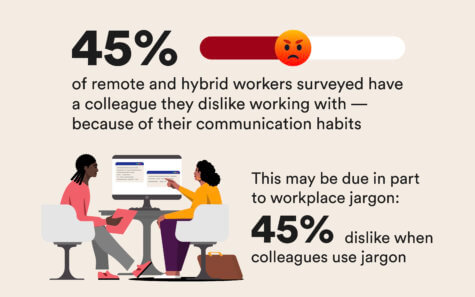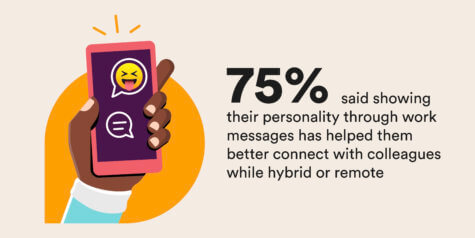NEW YORK — Do cliché work sayings have you rolling your eyes? You’re not alone. Almost half of Americans have a colleague they find difficult to work with — due to their communication habits.
A survey of 2,000 remote and hybrid workers revealed some of these feelings might result from their co-workers’ use of workplace jargon. The same percentage of respondents (45%) who have a co-worker they find difficult also dislike when colleagues use jargon, with terms like “give it 100 percent,” “think outside the box,” and “team player” ranking in the top 10 most overused phrases.
Let’s not circle back to the same old office jargon
Two-thirds of workers surveyed (63%) also think it’s off-putting when colleagues use workplace jargon in messages while communicating with them.
Commissioned by Slack and conducted by OnePoll, the results found that even though respondents dislike when others use jargon, they catch themselves doing it too. Eighty-nine percent admit they use workplace sayings, and the top reason they do so is to sound more professional or intelligent — tied with trying to maintain office norms (both 43%).
Of those, 55 percent have caught themselves using phrases they’re personally tired of hearing. Seventy-eight percent have stopped themselves from talking or sending a message to avoid using workplace jargon. Meanwhile, 83 percent have gone back and edited messages they’ve already sent to avoid these phrases.

OMG, remote work is getting informal
It’s not only workplace jargon that causes respondents to dislike communicating with their co-workers. The results found the level of formality can also have a huge impact — in a positive way. It turns out remote workers actually encourage others to use slang and abbreviations. Seven in 10 prefer when their co-workers communicate informally or with slang versus staying strictly professional.
That’s how respondents say they prefer to communicate, too. When using a messaging system, 38 percent use emojis, 36 percent use abbreviations, and 33 percent use slang. Another 31 percent who use GIFS and 24 percent who use all caps when indicating excitement.
“With 74 percent of respondents saying informal messages have made work feel more flexible and 71 percent noting it’s helped them to work more efficiently and productively, there should be little doubt that informal communication has evolved to become a mainstay of positive, inclusive and efficient workplace culture,” says Ali Rayl, senior vice president of product at Slack, in a statement.
“Informal communication through modern collaboration platforms helps overcome perceived barriers between senior leadership and their employees; leads to transparent and informative discussions; and makes work more fun, allowing employees to express themselves and create a more welcoming work environment.”

Keeping it casual
The desire for informal communication has been especially true during the pandemic: 75 percent say showing their personality through work messages (using emoji, GIFs, etc.) has helped them better connect with colleagues while not in the same office.
Seventy-three percent of respondents think informal work messages helped them navigate the transition to remote and hybrid work. This was especially true for younger employees: 80 percent of millennials agree, compared to 60 percent of Gen X respondents.
Seventy-eight percent feel work messages that use language beyond jargon and professional speak have made work feel more flexible, friendly, and inclusive, with 82 percent of millennials vs. 68 percent of Gen Xers agreeing.
Millennials are also more likely to agree that informal messages helped them avoid miscommunications and better understand someone’s intent while working separately from their colleagues — 73 percent versus 57 percent of Gen Xers.
“In this new world of working where teams are distributed, it’s important to be thoughtful and intentional in how we choose to communicate with our co-workers of all backgrounds, locations and ages, to ensure they stay connected and engaged,” Rayl adds. “With 72 percent of survey respondents hoping to continue to use informal work messages — instead of workplace jargon — going forward, we all need to consider which communication styles may be more effective with various co-workers.”
“Being mindful of how we communicate, you can help foster a productive and connected workplace. This is why we have created tools to allow for text-based synchronous and asynchronous communication as well as audio and video.”
WHICH WORKPLACE JARGON/PHRASES DO RESPONDENTS FIND OVERUSED OR BOTHERSOME?
- ASAP (15%)
- Keep me in the loop (15%)
- Just checking in (14%)
- Team player (14%)
- Give 110 percent (13%)
- Sorry for the delay (13%)
- New normal (13%)
- No worries (13%)
- Touch base (13%)
- Think outside the box (13%)
- Loop me in (13%)
- Back to square one (13%)
- Circle back (13%)
- There’s no I in team (13%)
